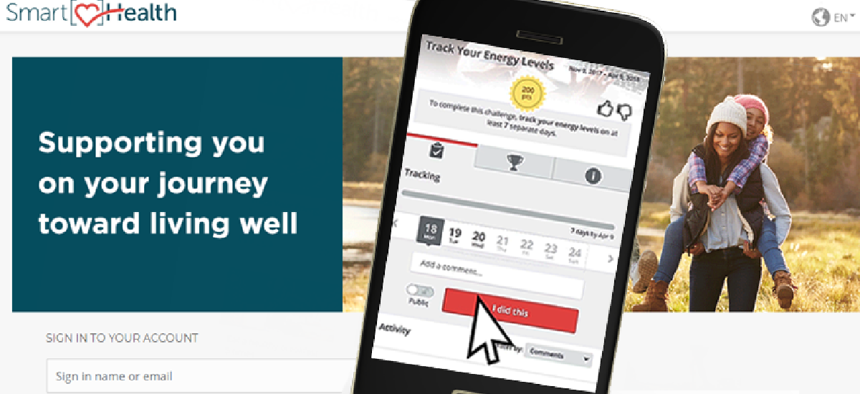Washington's employee wellness portal pays off


Connecting state and local government leaders
Since launching the SmartHealth program, the state has seen a 25 percent reduction in employee turnover, a 37 percent reduction in overtime and a 10 percent drop in the number of sick days taken.
To better attract and keep employees, some governments are taking a holistic approach -- literally. Officials are turning to technology that promotes well-being, tapping into the marriage of tech-managed work/life balances that many people already use.
Washington state launched the SmartHealth portal with employee engagement platform firm Limeade in 2015 that offers 130,000 employees and their spouses (plus eligible retirees) access to an online wellness program that covers physical, emotional, financial and work/life well-being. To use it, participants complete an initial wellness assessment and then track their personalized goals, which might include eating a healthy breakfast, taking the stairs, meditation, using a standing desk or just drinking more water. Part of Gov. Jay Inslee’s SmartHealth Initiative, this digital program has some 60,000 unique registrations so far.
The state does not track data on individual users. Rather, it gets aggregated reports from which officials might determine that a certain employee population is at risk of a given illness.
“We might have several thousand employees at the Department of Corrections, and if there’s a specific issue that is showing in their data like people are self-reporting that their stress is too high, then maybe the agency can take some steps or the agency director can take some focus on stress reduction or review work/lifestyle policies,” said David Iseminger, director of the Washington State Health Care Authority’s Employees and Retirees Benefits Division.
Administering the program costs about $3 million a year, and it’s well worth it, he said. The state has seen a 25 percent reduction in employee turnover, a 37 percent reduction in overtime and a 10 percent drop in the number of sick days taken. What’s more, about two-thirds of a cohort of about 15,000 to 20,000 employees who reported being at risk in any of 34 areas when they started the program four years ago have seen improvement.
“It’s very good for us to have a wellness program that’s integrated within all the benefits that we give or are part of the employment compensation package,” Iseminger said. “We think that there are a lot of different populations that can be served by this opportunity, whether it’s people who are healthy to maintain and be on the preventive side of sliding into health risks, or people who are on the edge of a diagnosis and if they change some of their habits, they’ll be able to avoid or hold off a chronic condition. … People who have a chronic condition might be able to reverse some of the more dramatic effects of those conditions," he said. "We really think there’s a time and a place for this for everybody.”
To encourage participation in the program, the division offers a $25 Amazon gift card to anyone who completes the SmartHealth Well-being Assessment and earns 800 points by participating in SmartHealth activities. Those who earn at least 2,000 points by joining and tracking activities quality for $125 off their deductible or have the money deposited in a health savings account. Other incentives -- including a chance to get two tickets to see the Seattle Seahawks play in the NFC championship -- encouraged 50,000 people to take the wellness assessment within five days, Iseminger said.
“It’s just getting them over that first line,” he said.
The use of technology to recruit and retain employees makes sense for governments, said Adelaide O’Brien, research director of Government Digital Transformation Strategies at IDC Government Insights.
“As public-sector organizations face increasing competition with other government entities, as well as with private-sector companies in attracting and retaining talent, workforce management is becoming an important tool in their competitive arsenal,” O’Brien said in an email to GCN. “Additionally, deploying best practices in talent excellence will help build a succession bench for leadership as well as inventory knowledge and skills.”
What’s more, such technology can prioritize the user experience and enable a digitally connected workforce. In the case of SmartHealth, workers can connect their smart watches, FitBits and Garmin fitness trackers as well as apps like MapMyRun and RunKeeper to the program. They can also opt into peer-to-peer challenges.
IDC recommends that managers “provide employees secure access to information on the same, efficient tools that they use in their private lives, such as phones, tablets, and desktops -- allowing employees familiar user interfaces in making data-driven decisions,” O’Brien said.
Other companies offering digital workforce management tools include Kronos, which built AIMEE, artificial intelligence for managers and employees. It uses algorithms to predict employees’ likeliness to resign or succeed, giving managers data on which to base conversations about engagement, retention and performance.
Santa Clara County, Calif., uses Kronos to gain visibility into real-time labor data so it can align staffing to improve productivity, control labor costs control and more easily comply with pay and work rules, according to a case study.
In Washington, Iseminger is looking to expand the digital wellness program to school employees, which would add another 130,000 to 140,000 employees and dependents. The state is also putting a new emphasis on behavioral health issues, such as incentivizing users to get preventative dental exams.
“There’s a lot of people who have found this to be a very intuitive, interactive and engaging opportunity,” Iseminger said of the program.
NEXT STORY: We need a sweeping 3D printing agenda, now




